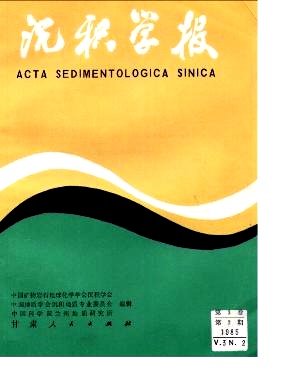PRELIMINARY STUDY ON THE ORIGIN OF THE RADIOLARIA- BEARING SILICEOUS ROCKS OF MAOKOU FORMATION (LOWER PERMIAN), SOUTHEAST HUBEI PROVINCE
- Received Date: 1983-07-19
- Publish Date: 1985-06-10
Abstract: From the field observation and study on petrology and paleobiology of the siliceous rocks of Maokou FormationCthe Lower Permian),Southeast Hubei Province, we have found many radiolarias, such as Stauroloche sp., Cenellipsis sp., Cenosph-aera sp., etc. and other geological evidences, which clearly indicate that these rocks accumulated in the environment close to the depth of calcite compositiou, and underwent a series of diagenetic changes, such as solution, redistribution, recrystallization and metasomatism after the depositon. All the processes of diagenetic changes are indicated by the following table. Processes of diagenetic changes of siliceous rocks The depth of depositional water has three differeent stages of changing from shallowness to deepness, which are consistent with the three divisional secti ons of siliceous rocks. The first stage of its deposition has argillaceous and silty siliceous rocks in the lower section and straum of concretion-bearing with collophanite in the floor section. They usually accumulate at the edge of shelf in the depth of about 100-200 meters. The second stage has banded siliceous rocks. They are mainly composed of siliceous sediment and carbonate. The presence of carbonate indicates that they have accumulated near CCD.The absence in carbonate,except radiolarias, of fossil community of fusulina and other foraminifera which were usually well developed in Permian incicates that the then depth of deposition was so deep that the calcareous skeletons of plankton were fully dissolved with no remainder left. The depositions in the third stage are rediolarias-bearing siliceous rocks without terrigenous fragment and carbonate.Its sedimentary environment was all situated under CCD. Obviously the siliceous rocks of Maokou formation (the Lower Permian ) in Southeast Hubei Province have deposited under sedimentary condition of trangression. Its southern zone, including Yangxin, Tongshan, Chongyang and Puqi, commonly locates in carbonate platform and has deposited biomicritic and biospar limestones? the northern zone, including Wuchang, Dayie, Huangshi and Guanji, has formed deep-water basin as a result of the crustal differential movement, and deposited siliceous rocks which represent the deep-water sediment. The sedimentary environment is located between the old land and the old rise on the broad shallow sea inside the platform. There was a western wind coming from the old equator through the continent to the sea surface,then it caused the rising of the colder ocean current, therefore, there was a great deal of radiolaras to breed. The deposition of the radiolaria-bearing siliceous rocks is obviously associated with the sink of the banded-active depression inside the platform. This sink of the banded-active depression has an influence not only on the sediment of Maokou formation ( the Lower Permian ) , but also obviously on the sediment of Lungton formation ( the Upper Permian ) .
| Citation: | Thong Yuming, Zhou Zuxun. PRELIMINARY STUDY ON THE ORIGIN OF THE RADIOLARIA- BEARING SILICEOUS ROCKS OF MAOKOU FORMATION (LOWER PERMIAN), SOUTHEAST HUBEI PROVINCE[J]. Acta Sedimentologica Sinica, 1985, 3(2): 67-74. |






 DownLoad:
DownLoad: